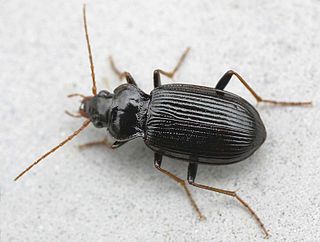Fischer's chameleon is a species of chameleon, a lizard in the family Chamaeleonidae. The species is endemic to Tanzania.

Aliivibrio fischeri is a Gram-negative, rod-shaped bacterium found globally in marine environments. A. fischeri has bioluminescent properties, and is found predominantly in symbiosis with various marine animals, such as the Hawaiian bobtail squid. It is heterotrophic, oxidase-positive, and motile by means of a single polar flagella. Free-living A. fischeri cells survive on decaying organic matter. The bacterium is a key research organism for examination of microbial bioluminescence, quorum sensing, and bacterial-animal symbiosis. It is named after Bernhard Fischer, a German microbiologist.

Euprymna scolopes, also known as the Hawaiian bobtail squid, is a species of bobtail squid in the family Sepiolidae native to the central Pacific Ocean, where it occurs in shallow coastal waters off the Hawaiian Islands and Midway Island. The type specimen was collected off the Hawaiian Islands and is deposited at the National Museum of Natural History in Washington, D.C..

Fischer's clawed salamander, Onychodactylus fischeri, is a lungless salamander found in Northeast Asia. It ranges through northeastern China, the Russian Far East, and the Korean Peninsula, but is only sporadically distributed within this range. Within South Korea, it is found chiefly in the high mountain valleys of Gangwon province, including the Gwangdeoksan and Daeseongsan regions. The adults feed on spiders, grubs, and insects. It is also known as the long-tailed clawed salamander.

Fischer's turaco is a species of bird in the family Musophagidae. It is found in Kenya, Somalia, and Tanzania. Its natural habitats are subtropical or tropical moist lowland forest, subtropical or tropical moist montane forest, and arable land. It is threatened by habitat loss.

The straw-tailed whydah is a species of bird in the family Viduidae. It is found in Ethiopia, Kenya, Somalia, South Sudan, Tanzania, and Uganda. Its natural habitat is dry savanna. Like all other whydah species, the straw-tailed whydah is a brood parasite.

The Fischer's shrew is a species of mammal in the family Soricidae. It is found in Egypt, Kenya, and Tanzania. Its natural habitat is dry savanna. It is threatened by habitat loss.

The Fischer's pygmy fruit bat or Philippine pygmy fruit bat is a species of megabat in the family Pteropodidae. It is monotypic within the genus Haplonycteris. It is endemic to the Philippines. Its natural habitat is subtropical or tropical dry forests. It is threatened by habitat loss.

Nebria is a genus of ground beetles native to the Palearctic, the Near East and North Africa.

Nebria brevicollis is a species of ground beetle native to Europe and the Near East. In Europe, it is found in all countries and islands except the Azores, the Canary Islands, the Channel Islands, Franz Josef Land, Gibraltar, Madeira, Malta, Monaco, the North Aegean Islands, Novaya Zemlya, San Marino, the Selvagens Islands, Svalbard and Jan Mayen, and Vatican City. It has now been reported as introduced in western Oregon, U.S.A., where it has been found in highly disturbed sites as well as in native old-growth forest stands. It has also now been found in Washington State.

Nebria livida is a species of ground beetle with two subspecies:
Nebria aetolica is a species of ground beetle in the Nebriinae subfamily that can be found in Albania, Greece, and North Macedonia.
Nebria dahlii is a species of ground beetle in the Nebriinae subfamily that can be found in Austria, all states of former Yugoslavia, and Italy.
Nebria rubripes is a species of ground beetle in the Nebriinae subfamily that can be found in France and Spain.
Nebria tatrica is a species of ground beetle in the Nebriinae subfamily that can be found in Poland Czech Republic and Slovakia.
Nebria laticollis is a species of ground beetle in the Nebriinae subfamily that can be found in France, Italy, and Switzerland.
Nebria cordicollis is a species of black coloured ground beetle from Nebriinae subfamily that can be found in Italy and Switzerland. The species is 5 millimetres (0.20 in) long.
Johann Gustav Fischer was a German herpetologist.












